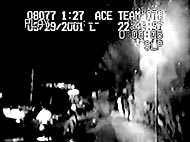5/1/2007
Supreme Court Authorizes Lethal Force in Traffic PursuitsUS Supreme Court decision allows police to use deadly force to end a high-speed chase.

The US Supreme Court yesterday ruled that it was permissible to use lethal force against motorists accused only of violating a traffic law if the police determine their driving to be "dangerous." Justice Antonin Scalia wrote the majority opinion for eight of the court's nine members.
"We lay down a more sensible rule," Scalia wrote. "A police officer's attempt to terminate a dangerous high-speed car chase that threatens the lives of innocent by-standers does not violate the Fourth Amendment, even when it places the fleeing motorist at risk of serious injury or death."
The case was based on a March 29, 2001 incident where a Coweta County, Georgia deputy clocked Victor Harris, then 19 years old, driving at 73 MPH in a 55 MPH zone on a divided, four-lane stretch of Highway 34. Harris refused to pull over, speeding away at 85 MPH on a two-lane portion of the road just before 11pm. Several police vehicles entered pursuit for about ten miles until Officer Timothy Scott, without issuing any warning over his loudspeaker, rammed Harris' vehicle causing it to spin, overturn and crash. The accident left Harris a quadriplegic.
The majority based its decision on a videotape showing the cars of passing motorists had pulled to the side of the road in the course of the pursuit (view video). The majority viewed this as evidence that other motorists had swerved to avoid Harris, while dissenting Justice John Paul Stevens believed it was equally likely that they had pulled over after hearing the approaching police sirens. After viewing the video, Scalia called it a "Hollywood-style car chase of the most frightening sort."
"It was respondent, after all, who intentionally placed himself and the public in danger by unlawfully engaging in the reckless, high-speed flight that ultimately produced the choice between two evils that Scott confronted," Scalia wrote. "Whereas Scott's action -- ramming respondent off the road -- was certain to eliminate the risk that respondent posed to the public, ceasing pursuit was not."
Stevens responded that it is not the business of nine judges in Washington, DC to overturn the decision of a court or jury in Georgia familiar with what constitutes dangerous driving on particular roads.
"A high speed chase in a desert in Nevada is, after all, quite different from one that travels through the heart of Las Vegas," Stevens explained in his dissent.
Stevens then challenged the majority's emotional interpretation of the videotape.
"I can only conclude that my colleagues were unduly frightened by two or three images on the tape that looked like bursts of lightning or explosions, but were in fact merely the headlights of vehicles zooming by in the opposite lane," Stevens wrote. "Had they learned to drive when most high-speed driving took place on two-lane roads rather than on superhighways -- when split-second judgments about the risk of passing a slow-poke in the face of oncoming traffic were routine -- they might well have reacted to the videotape more dispassionately."
In agreement with the conclusions of the lower court, Stevens challenged the notion that the videotape showed Harris doing anything dangerous on Highway 34. Stevens detailed how Harris waited until it was safe before performing any passing maneuvers while, in almost every case, using his turn signal.
"This is hardly the stuff of Hollywood," Stevens wrote.
Stevens concluded that, "it seems eminently likely that a reasonable juror could disagree with this court's characterization of events" because there were no innocent bystanders threatened in this case. He suggested the majority's approval of excessive force would make it less likely for police to consider less drastic alternatives in the future.
The full text of the decision is available in a 323k PDF file at the source link below. The full video of the chase is available on Google Video.


